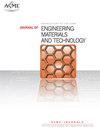Characterizing the Fatigue Behavior of Wrought Fe-Co-2V using Experimental Techniques
IF 1.9
4区 材料科学
Q3 ENGINEERING, MECHANICAL
Journal of Engineering Materials and Technology-transactions of The Asme
Pub Date : 2022-03-22
DOI:10.1115/1.4054142
引用次数: 1
Abstract
Fe-Co-2V (Hiperco equivalent) is a soft ferromagnetic material that is commonly used for electrical components that require robust magnetic performance. Despite the excellent magnetic properties of Fe-Co-2V, it often exhibits low strength, ductility, and workability due to an ordered B2 microstructure. The mechanical properties exhibit considerable dependency on grain size and degree of order, which are influenced by processing methods. A thorough understanding of Fe-Co-2V’s fatigue performance is required to predict mechanical reliability under operating loads; however, limited fatigue data currently exists for Fe-Co alloys. This work characterizes the fatigue properties of wrought Fe-Co-2V through strain-controlled fatigue testing and fractography. Young’s Modulus, ultimate strength, and yield stress were determined through monotonic tension tests. The fatigue behavior was quantified using fully reversed, strain-controlled fatigue testing for applied strain amplitudes ranging from 0.10% to 1.00%. Subsequently, the Coffin-Manson strain-life curve was fit to the experimental data. Failure mechanisms were investigated through fractography with a scanning electron microscope. Inspection of the failure surfaces revealed that crack initiation occurred at defects located on or near the specimen surface with a localized region of crack propagation prior to the transgranular cleavage fracture. Additionally, two material models were calibrated from the experimental static and cyclic experimental testing. The characterization of the fatigue behavior of wrought Fe-Co-2V presented herein will aid in the fatigue analysis of Fe-Co-2V components and the development of analytical fatigue modelling methodologies.用实验技术表征锻造Fe-Co-2V的疲劳行为
Fe-Co-2V(Hiperco等效物)是一种软铁磁材料,通常用于需要坚固磁性性能的电气部件。尽管Fe-Co-2V具有优异的磁性,但由于有序的B2微观结构,它通常表现出较低的强度、延展性和可加工性。机械性能表现出对晶粒尺寸和有序度的相当大的依赖性,这受到加工方法的影响。需要全面了解Fe-Co-2V的疲劳性能,才能预测工作负载下的机械可靠性;然而,目前Fe-Co合金的疲劳数据有限。本工作通过应变控制疲劳试验和断口分析表征了锻造Fe-Co-2V的疲劳性能。杨氏模量、极限强度和屈服应力通过单调拉伸试验确定。使用完全反向的应变控制疲劳试验对疲劳行为进行量化,施加的应变幅度在0.10%-1.00%之间。随后,Coffin-Manson应变寿命曲线与实验数据相拟合。通过扫描电子显微镜的断口形貌研究了失效机理。对失效表面的检查表明,裂纹萌生发生在试样表面上或附近的缺陷处,在穿晶解理断裂之前,裂纹扩展的局部区域。此外,从实验静态和循环实验测试中校准了两个材料模型。本文提出的锻造Fe-Co-2V疲劳行为的表征将有助于Fe-Co-2V部件的疲劳分析和分析疲劳建模方法的发展。
本文章由计算机程序翻译,如有差异,请以英文原文为准。
求助全文
约1分钟内获得全文
求助全文
来源期刊
CiteScore
3.00
自引率
0.00%
发文量
30
审稿时长
4.5 months
期刊介绍:
Multiscale characterization, modeling, and experiments; High-temperature creep, fatigue, and fracture; Elastic-plastic behavior; Environmental effects on material response, constitutive relations, materials processing, and microstructure mechanical property relationships

 求助内容:
求助内容: 应助结果提醒方式:
应助结果提醒方式:


